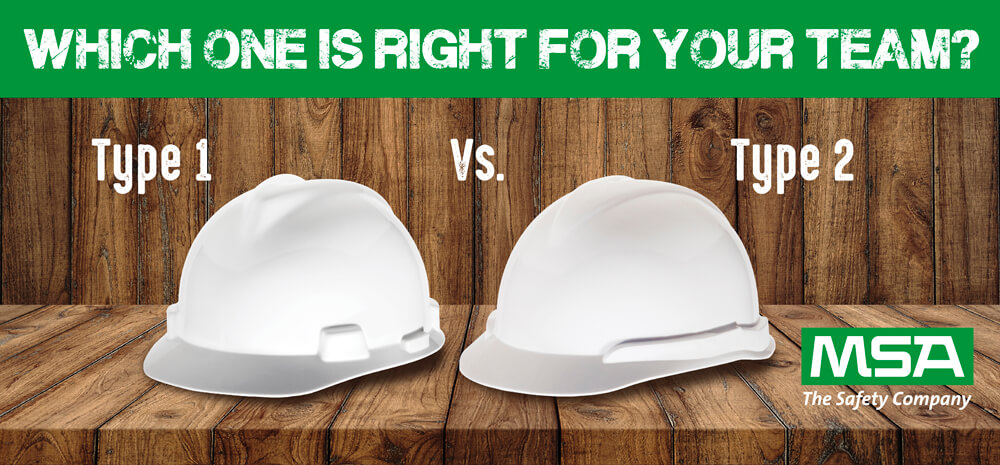
Every job site is hazardous. Period. No ifs, ands, or buts. Unfortunately, as work forces grow, so do the risks for employee injury. With each job site posing a unique set of hazards to your teams, it is extremely important you understand the challenges your teams face and the best options to protect them. With many options to consider, the best place to start is to protect the head. To help get you started, MSA created a short summary of the protective qualities of type 1 and type 2 helmets. Check it out below!
Industrial protective helmets are classified by impact type and electrical class per ANSI Z89.1-2014. All protective helmets are
required to meet either Type I or Type II requirements. If hazard potential is for top impact, a Type I helmet should be considered.
If hazards are present that can impact the front, back and sides, as well as the top of a helmet, use of a Type II helmet should be
considered. If application hazards are present that may cause a helmet to dislodge from a user’s head, use of a chinstrap should be
considered for additional safety and helmet retention.
Type I Helmets
Type I helmets are designed to reduce impact force as a result
of a blow to only the top of the head. There are four specific
performance requirements for Type I helmets:
-
Flammability
-
No flame can be visible for five seconds after removing
the test flame from the helmet surface.
-
Force transmission
-
A single helmet must not transmit force to
the test head form exceeding 1,000 pounds of force.
-
Conditioned helmets (hot and cold) shall be averaged,
and the average cannot exceed 850 pounds of force to
the test head form.
-
Apex penetration
-
The penetrator cannot make contact with the top of the
head form.
-
Electrical classification (Class G, Class E or Class C)
-
Class G and Class E helmets must meet appropriate
performance requirements.
-
Class G to withstand 2,200 volts for one minute.
Maximum leakage shall not exceed three milliamperes.
- Class E to withstand 20,000 volts for three minutes
after impact. Maximum leakage shall not exceed
nine milliamperes.
- Class C helmets are not tested for electrical insulation.
|
Type II Helmets
Type II helmets are designed to reduce impact force as a result
of a blow to the top or sides of the head. In addition to the
four performance requirements of a Type I helmet, Type II
performance criterion contains three additional requirements:
- Flammability
- Force transmission
- Apex penetration
- Electrical classification (Class G, Class E or Class C)
- Impact energy attenuation
-
Helmet is dropped onto a spherical object at various
angles around the helmet, above a designated test line.
- Off-center penetration
-
A penetrator is dropped vertically, and the helmet is
rotated at different angles above a designated test line.
The penetrator cannot contact the headform.
- Chinstrap retention (optional)
-
If a Type II helmet is provided with a chin strap, chin strap
must be tested for retention, must remain attached to the
helmet and must not stretch beyond one inch in length.
|
|
MSA Type I Helmets
|
MSA Type II Helmets
|
V-Gard® Caps and Hats
V-Gard 500 Caps and Hats
SmoothDome® Caps
Topgard® Caps and Hats
Thermalgard® Caps
Skullgard® Caps and Hats
|
Super V® Helmets
Vangaurd™ Helmets

|

 Wayne Enterprises, Inc.
Wayne Enterprises, Inc.